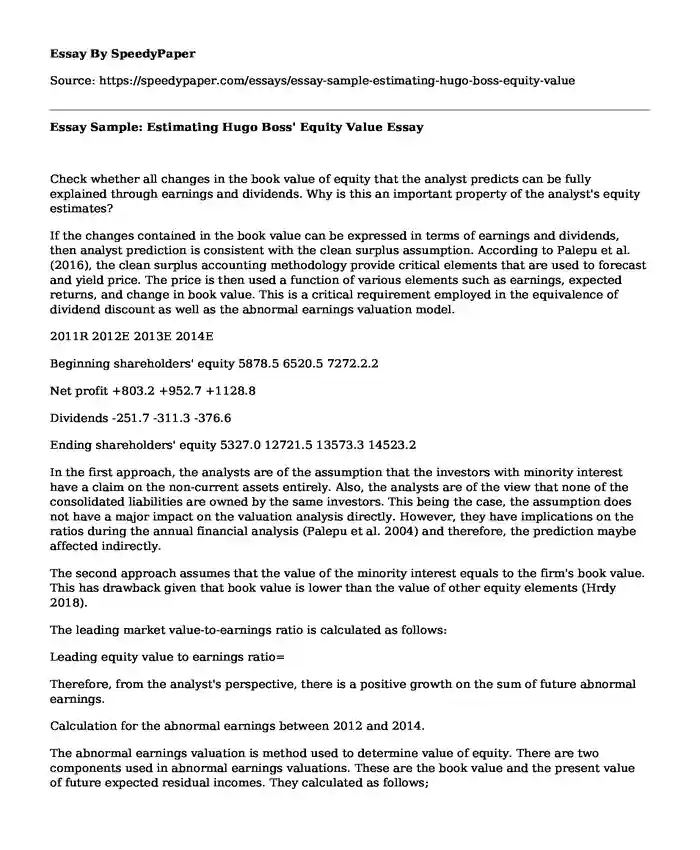
| Type of paper: | Essay |
| Categories: | Financial management |
| Pages: | 3 |
| Wordcount: | 714 words |
Check whether all changes in the book value of equity that the analyst predicts can be fully explained through earnings and dividends. Why is this an important property of the analyst's equity estimates?
If the changes contained in the book value can be expressed in terms of earnings and dividends, then analyst prediction is consistent with the clean surplus assumption. According to Palepu et al. (2016), the clean surplus accounting methodology provide critical elements that are used to forecast and yield price. The price is then used a function of various elements such as earnings, expected returns, and change in book value. This is a critical requirement employed in the equivalence of dividend discount as well as the abnormal earnings valuation model.
2011R 2012E 2013E 2014E
Beginning shareholders' equity 5878.5 6520.5 7272.2.2
Net profit +803.2 +952.7 +1128.8
Dividends -251.7 -311.3 -376.6
Ending shareholders' equity 5327.0 12721.5 13573.3 14523.2
In the first approach, the analysts are of the assumption that the investors with minority interest have a claim on the non-current assets entirely. Also, the analysts are of the view that none of the consolidated liabilities are owned by the same investors. This being the case, the assumption does not have a major impact on the valuation analysis directly. However, they have implications on the ratios during the annual financial analysis (Palepu et al. 2004) and therefore, the prediction maybe affected indirectly.
The second approach assumes that the value of the minority interest equals to the firm's book value. This has drawback given that book value is lower than the value of other equity elements (Hrdy 2018).
The leading market value-to-earnings ratio is calculated as follows:
Leading equity value to earnings ratio=
Therefore, from the analyst's perspective, there is a positive growth on the sum of future abnormal earnings.
Calculation for the abnormal earnings between 2012 and 2014.
The abnormal earnings valuation is method used to determine value of equity. There are two components used in abnormal earnings valuations. These are the book value and the present value of future expected residual incomes. They calculated as follows;
DCF = [CF1 / (1+r)1] + [CF2 / (1+r)2] + ... + [CFn / (1+r) n]
CF = Cash Flow
r= discount rate (WACC)
DCF is also referred to as the Discounted Cash Flows (Palepu et al. 2016). In this calculation, the residual income stream is used instead of Weighted Average Cost of Capital (WACC). The WAAC is used to determine the overall company's cost of equity (Palepu et al. 2016). Therefore, if the present value is positive, the firms can create value beyond book value of the company.
2012 2013 2014
(a) Beginning group equity 5878.5 6520.5 7272.2
(b) "Normal" profit = (a) x 0.12 705.4 782.5 872.7
(c) Group profit 523.2 558.2 597.3
(d) Abnormal earnings = (c) - (b) 182.2 224.3 275.4
Alternatively, the abnormal earnings can be achieved by focusing on the shareholders' equity and net profit (Palepu et al. 2016). This is illustrated below.
2012 2013 2014
(a) Beginning group equity 5878.5 6520.5 7272.2
(b) "Normal" profit = (a) x 0.12 705.4 782.5 872.7
(c) Net profit 523.2 558.2 597.3
(d) Abnormal earnings = (c) - (b) 182.2 224.3 275.4
Assume that abnormal earnings in 2015 and beyond are zero. Estimate the value of Adidas's group equity (group equity is the sum of shareholders' equity and minority interests). What might explain the difference between your equity value estimate and Adidas's actual market value (of 12,247 million)?
The abnormal earnings valuation model is premised on the philosophy that the price above or below the book value is due to expertise employed by the firm's management (Palepu et al. 2016). Therefore, it becomes a critical tool for determining the real value of the stock.
2011R 2012E 2013E 2014E
(a) Beginning group equity 5878.5 6520.5 7272.2 5878.5
(b) Abnormal (group) earnings 182.2 224.3 275.4
(c) Discount factor (r = 12%) 0.2989 0.6279 0.8227
(d) Discounted abnormal (group) earnings 45.3 79.3 71.3
In this calculation, Hugo's estimate is extremely lower than Adidas current market. This is due to the fact that the analyst assumptions are that the abnormal earnings is zero after 2014. While it is reasonable to expect that the competition will reduce Adidas' abnormal earnings in the future, this will not happen instantly. As such, it is necessary to also include Adidas estimation value that begins from 2011 abnormal earnings, for instance, the terminal value.
References
Hrdy, M. 2018. Valuation Standards for Commercial Banks in the Financial Theory and their Analysis. Prague Economic Papers, 1-13. http://dx.doi.org/10.18267/j.pep.661
Palepu, K., Healy, P., & Bernard, V. 2004. Business analysis and valuation using financial statements: text and cases. Mason, Ohio, USA: Thomson South-Western.
Palepu, K., Healy, P., & Peek, E. 2016. Business analysis and valuation. Andover: Cengage Learning EMEA.
Cite this page
Essay Sample: Estimating Hugo Boss' Equity Value. (2022, May 02). Retrieved from https://speedypaper.net/essays/essay-sample-estimating-hugo-boss-equity-value
Request Removal
If you are the original author of this essay and no longer wish to have it published on the SpeedyPaper website, please click below to request its removal:
- Sociological Imagination Paper Example
- Data Science Essay Example
- Essay Example on How to Reduce Stress for Students
- Ethical Issues with an Aging Population, Essay Example
- Free Paper for You: An Invitation to the Course of Technical Writing
- Covering International News
- Free Essay - Now What Do I Do With Brad and Kerry
Popular categories




